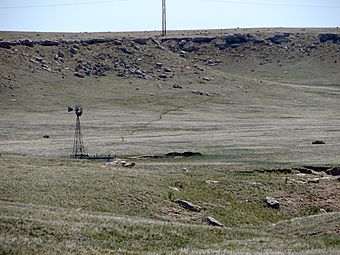Deadwood Draw facts for kids
Quick facts for kids |
|
|
Deadwood Draw
|
|

Deadwood Draw
|
|
| Location | Northwest of Sidney, Nebraska |
|---|---|
| Built | 1874 to 1881 |
| NRHP reference No. | 92001574 |
| Added to NRHP | October 8, 1992 |
Deadwood Draw is an important historical place near Sidney, Nebraska. It was a key part of the Sidney-Black Hills Trail, which was used to carry supplies to gold miners in the Black Hills between 1874 and 1881. Deadwood Draw served as a "staging area" where large freight wagons would gather before heading out. You can still see the deep ruts left by the wagon wheels and the animals that pulled them. This historic spot is listed on the National Register of Historic Places.
Contents
The Black Hills Gold Rush Story
In 1868, the U.S. government made a promise to the Lakota people with the Fort Laramie Treaty. This treaty said that the Black Hills would be protected and no white settlers would move there.
However, in 1874, an explorer named George Armstrong Custer led a trip into the Black Hills. He found gold! This discovery led to the Black Hills Gold Rush in 1876. Many people rushed to the area hoping to find their fortune.
The U.S. government first tried to buy or rent the Black Hills from the Lakota. But they couldn't agree on a price. So, the government decided to ignore the treaty and let the gold seekers rush in. This created a huge need for supplies for all the new miners.
Sidney, Nebraska: A Supply Hub
In 1876, Sidney, Nebraska, was a small town located on the Union Pacific Railroad. Sidney became a very important starting point for sending supplies to the Black Hills. It had two big advantages over other towns:
- First, there was already a trail going north from Sidney to the Red Cloud Agency. This trail was protected by soldiers from Fort Sidney and Fort Robinson.
- Second, the route from Sidney was shorter than other possible supply routes. Also, a new toll bridge called the Clarke Bridge was built over the North Platte River by Henry T. Clarke, Sr.. This made it much easier for freight wagons to travel on the Sidney-Black Hills Trail.
Once the Clarke Bridge opened, the Sidney-Black Hills Trail became incredibly busy. Huge amounts of supplies were moved to and from the Black Hills mines. In the summer of 1876, the Pony Express even started using the trail, along with several stagecoach lines.
At that time, about 10,000 gold seekers were in the Black Hills. They needed so many supplies that 50 to 75 freight wagons left Sidney every single day! Each wagon carried about 8,000 pounds (3,600 kg) of goods.
The Trail's End
By 1879, the Black Hills Gold Rush started to slow down. There wasn't as much need for passenger services like stagecoaches. However, large mining companies continued to operate, so the need for freight transportation actually increased for a while.
From 1878 to 1879, an amazing 20,000,000 pounds (9,100,000 kg) of supplies were moved to and from Sidney! But by 1880, a new railroad, the Chicago and Northwestern Railroad, was completed to Pierre, South Dakota. This new railroad made it much faster and cheaper to transport supplies.
Because of the new railroad, the amount of freight carried on the Sidney-Black Hills Trail dropped a lot. By the end of 1882, the trail was completely closed.
What Deadwood Draw Looks Like
Deadwood Draw is located about 3 miles (4.8 km) northwest of Sidney, Nebraska. It's close to the Union Pacific Railroad, which made it easy to load supplies onto wagons.
The draw is a wide, flat area that gently slopes up from the Lodgepole Creek Valley. A winding gully channel runs through the draw, ranging from 3 feet (0.9 m) to 10 feet (3 m) deep. In 1992, when it was added to the National Register of Historic Places, you could still see three sets of wagon-wheel ruts. There were also ruts made by the oxen and horses that pulled the wagons. These rut pairs are between 4.1 meters (13.5 ft) and 5 meters (16.4 ft) wide.
Why Deadwood Draw is Important
Deadwood Draw was a vital "staging area" for all the freight wagons using the Sidney-Black Hills Trail. It's historically important because it still has very well-preserved ruts from the freight wagons, stagecoaches, and animals that used the trail from 1874 to 1881.
On the south side of the draw, there's a dip in the ground. Experts believe this might be what's left of a 19th-century dugout shelter. Someone might have lived there during the busy gold rush years. Also, near the middle of the draw, there's a small limestone quarry. This quarry provided much of the limestone used to build the first buildings in Sidney.
See also
 In Spanish: Deadwood Draw para niños
In Spanish: Deadwood Draw para niños



